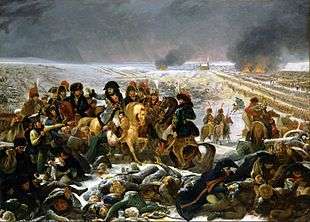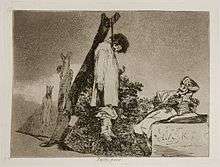Napoleonic Wars casualties
.jpg)
The casualties of the Napoleonic Wars (1803–1815), direct and indirect, break down as follows:
Note that the following deaths listed include both killed in action as well as deaths from other causes; Deaths from diseases such as those from wounds; of starvation; exposure; drowning; friendly fire; and atrocities; Medical treatments were changed drastically at this time. 'Napoleon's Surgeon', Baron Dominique Jean Larrey, used horse-drawn carts as ambulances to quickly remove the wounded from the field of battle. This method became so successful that he was subsequently asked to organize the medical care for the 14 armies of the French Republic.
French Empire
- 371,000 killed in action[1]
- 800,000 killed by wounds, accidents or disease, primarily in the disastrous invasion of Russia[2]
- 600,000 civilians[2]
- 65,000 French allies (mainly Poles fighting for independence lost in 1795)[2]
- 1,800,000 French and allies (mostly Germans and Poles) dead in action, disease and missing[1]
- 1,700,000 Frenchmen from "pre-1792 borders"
The effect of the war on France over this time period was considerable. According to David Gates, the Napoleonic Wars cost France at least 916,000 men. This represents 38% of the conscription class of 1790–1795. This rate is over 14% higher than the losses suffered by the same generation one hundred years later fighting Imperial Germany.[3] The French population suffered long-term effects through a low male-to-female population ratio. At the beginning of the Revolution, the numbers of males to females was virtually identical. By the end of the conflict only 0.857 males remained for every female.[4] Combined with new agrarian laws under the Napoleonic Empire that required landowners to divide their lands to all their sons rather than the first born, France's population never recovered. By the middle of the XIXth century France had lost her demographic superiority over Germany and Austria and even the United Kingdom.
Allies

- 120,000 Italian dead or missing[5]
- 289,000 Russian dead or missing
- 134,000 Prussian dead or missing
- 376,000 Austrian dead or missing
- 586,000 Spanish dead[6]
- 200,000 Portuguese dead or missing
- 311,806 British dead or missing.[7]
Total: 2,015,000
- Royal Navy, 1804–15
- killed in action: 6,663
- shipwrecks, drownings, fire: 13,621
- wounds, disease: 72,102
Total: 92,386.[8]
- British Army, 1804–15
- killed in action: 25,569
- wounds, accidents, disease: 193,851
Total: 219,420[8]
Total dead and missing
- 2,500,000 military personnel in Europe
- 1,000,000 civilians were killed in Europe and in rebellious French overseas colonies.[9]
Total: 3,500,000 casualties
David Gates estimated that 5,000,000 died in the Napoleonic Wars. He does not specify if this number includes civilians or is just military.[10]
Charles Esdaile says 5,000,000–7,000,000 died overall, including civilians.[11] These numbers are subject to considerable variation. Erik Durschmied, in his book The Hinge Factor, gives a figure of 1.4 million French military deaths of all causes. Adam Zamoyski estimates that around 400,000 Russian soldiers died in the 1812 campaign alone—a figure backed up by other sources. Civilian casualties in the 1812 campaign were probably comparable. Alan Schom estimates some 3 million military deaths in the Napoleonic wars and this figure, once again, is supported elsewhere. Common estimates of more than 500,000 French dead in Russia in 1812 and 250,000–300,000 French dead in Iberia between 1808 and 1814 give a total of at least 750,000, and to this must be added hundreds of thousands of more French dead in other campaigns—probably around 150,000 to 200,000 French dead in the German campaign of 1813, for example. Thus, it is fair to say that the estimates above are highly conservative.
Civilian deaths are impossible to accurately estimate. Whilst military deaths are invariably put at between 2.5 million and 3.5 million, civilian death tolls vary from 750,000 to 3 million. Thus estimates of total dead, both military and civilian, can reasonably range from 3,250,000 to 6,500,000.
References
- Esdaile, C. 2008. Napoleon's Wars: An International History 1803–1815. New York: Penguin Group. Viking.
- Hall, C. 1992. British Strategy in the Napoleonic war, 1803–15. Manchester: Manchester University Press.
- Gates, David (2011), The Napoleonic Wars 1803–1815, Random House.
- Philo, Tom (2010), Military and Civilian War Related Deaths Through the Ages, archived from the original on 20 April 2010
- White, Matthew (2011), "Statistics of Wars, Oppressions and Atrocities of the Nineteenth Century (the 1800s)", the Historical Atlas of the 20th Century, http://necrometrics.com/ (Matthew White) External link in
|publisher=(help).[lower-alpha 1] White cites:- Ellis, Geoffrey (2003) [1991], The Napoleonic Empire (2d ed.), cites Esdaile
- Dumas, Samuel (1923), Losses of Life Caused By War cites four sources
- Bodart, Gaston (1916), Losses of Life in Modern Wars
- Urlanis, Boris (1971), Wars and Population
- Clodfelter, Michael, Warfare and Armed Conflict: A Statistical Reference to Casualty and Other Figures, 1618–1991
- Payne, Stanley G., A History of Spain and Portugal, 2
- Levy, Jack (1983), War in the Modern Great Power System[lower-alpha 2]
- Eckhardt, William (1987), "Three page table", in Sivard, Ruth Leger, World Military and Social Expenditures 1987–88 (12th ed.)
- Sorokin, Pitiri (1962) [1937], In Three volumes, ed., Social and Cultural Dynamics[lower-alpha 2]
- http://necrometrics.com/wars19c.htm
Footnotes
- ↑ White notes: "The era of almost continuous warfare that followed the overthrow of the French monarchy is traditionally split into three parts: The Revolution itself (including all internal conflicts) The Revolutionary Wars during which France fought international wars as a Republic" (White 2011).
- 1 2 White notes in section called "Main sequence" on another page "There's a string of authorities who seem to build their research on each other's earlier guesstimates: Sorokin, Small & Singer, Eckhardt, Levy, Rummel, the Correlates of War Project, etc. Most mainstream statistical analysis of war is based on these authorities; however, if you look at the individual authorities on the Main Sequence, you'll see that some have specific problems that carry over as they borrow from one another. See the wars in Algeria or South Africa for examples of how the Main Sequence agrees with itself and not with historians of the specific war" (White 2011).
- 1 2 White 2011 cites Bodart 1916
- 1 2 3 Philo 2010.
- ↑ Gates, David. The Napoleonic Wars 1803–1815. New York: St. Martin's Press Inc., 272.
- ↑ Blanning, Tim. The Pursuit of Glory: The Five Revolutions that Made Modern Europe. New York: Penguin Group Copyright 2007. 672.
- ↑ White, Matthew. "Statistics of Wars, Oppressions and Atrocities of the Nineteenth Century".
- ↑ http://www.uclm.es/ab/humanidades/profesores/descarga/manuel_ortiz/crisisregimen.pdf
- ↑ White 2011 cites Dumas 1923 citing Hodge: 92,386 Royal Navy + 219,420 British Army
- 1 2 White 2011 cites Dumas 1923 citing Hodge
- ↑ White 2010 cites Ellis 2003 (citing Esdaile); Eckhard 1987; Fröhlich
- ↑ (Gates).
- ↑ Esdaile.
